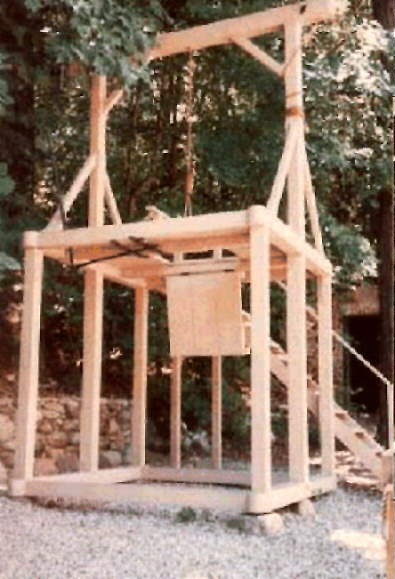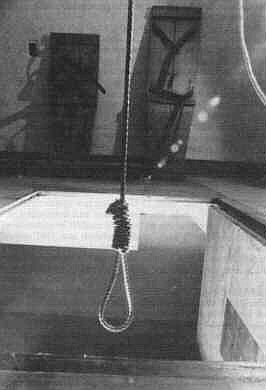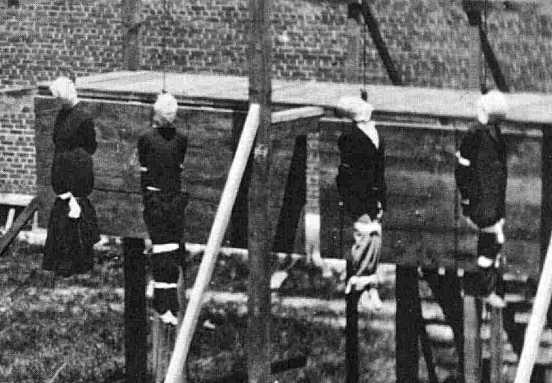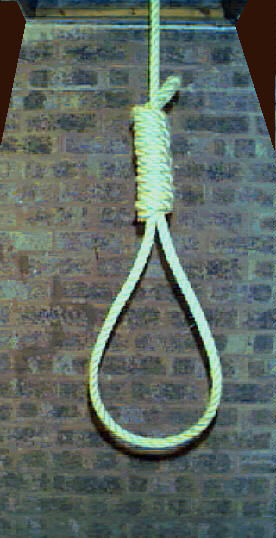Hanging with no or insufficient drop typically produces death by strangulation (asphyxia) due to the weight of the person's body pulling down on the noose, causing it to tighten and constrict the trachea (air passage) and applying pressure to the large blood vessels in the neck. The condemned person usually struggles for some time after suspension, due to the physical pain caused by the noose. It can take up to 3 minutes for the person to lapse into unconsciousness in this form of hanging, as the rope occludes the jugular veins and carotid arteries but the vertebrae protect the vertebral and spinal arteries which also supply blood to the brain. However these arteries go outside the fourth vertebrae instead of inside it, which subjects them to blockage if the pressure on the neck is high enough (usually about 40-50 lbs. for a normal person) and this can cause the loss of consciousness in less than 15 seconds. Death can also come from sudden stoppage of the heart due to pressure on the carotid arteries which can cause a lethal carotid sinus reflex or from Vagal reflex (pressure on the Vagal nerve) which causes unconsciousness very quickly. This form of hanging is typical in suicides and it quite normal for the inquest to find that the victim died from heart failure rather than strangulation.
After suspension the face may become engorged and cyanosed (turned blue through lack of oxygen). The tongue may protrude and rippling movements of the body and limbs may occur which are usually attributed to nervous and muscular reflexes. There exist many pictures of actual hangings, both judicial and suicide, which seem to show that the person died quickly and quite peacefully.
In death, the body typically shows marks of suspension, e.g. bruising and rope marks on the neck and in some cases traces of urine, semen and feces. Male prisoners sometimes have penile erections and even ejaculate while hanging.
This form of asphyxial death is known, medically as anoxia as the brain becomes starved of oxygen. Whole body death results usually within less than twenty minutes.
Where a measured drop is used, it takes between a quarter and a third of a second for a person to reach the end of the rope after the trap opens. The force produced by the prisoner's body weight multiplied by the length of fall and the force of gravity, coupled with the position of the knot is designed to cause a virtually instant fracture-dislocation of the neck which leads to death by comatose asphyxia. Typically brain death will occur in around 3 - 6 minutes and whole body death within 5 - 15 minutes.
The cause of death is still asphyxia but the condemned person is deeply unconscious at the time due to dislocation of the cervical vertebrae and the crushing or separation of the spinal cord. The face may come engorged and then cyanosed and the tongue may protrude. Some slight movements of the limbs and body may occasionally occur and are attributed to spinal reflexes. The prisoner may urinate and/or defecate as their muscles relax. The heart can continue to beat for as long as 25 minutes after the drop.
Does the prisoner feel pain after the drop?
Obviously no one can be sure but it is generally held that if they do feel pain, it is only during the instant that their neck is broken.
The witnessed hangings of Westley Allan Dodd (see above) in Washington and Billy Bailey in Delaware did not indicate any obvious signs of conscious suffering.
It is probable that many people black out as they fall through the trap and are already unconscious before they reach the end of the drop.
However, according to Harold Hillman, a British physiologist who has studied executions, "the dangling person probably feels cervical pain, and suffers from an acute headache, as a result of the rope closing off the veins of the neck. It had been generally assumed that fracture-dislocation of the neck causes instantaneous loss of sensation. Sensory pathways from below the neck are ruptured, but the sensory signals from the skin above the noose and from the trigeminal nerve may continue to reach the brain until hypoxia blocks them".
In the opinion of Dr. Cornelius Rosse, the chairman of the Department of Anatomy at the University of Washington School of Medicine, the belief that fracture of the spinal cord causes instantaneous death is wrong in all but a small fraction of cases.
Botched hangings
Back to Execution Methods




